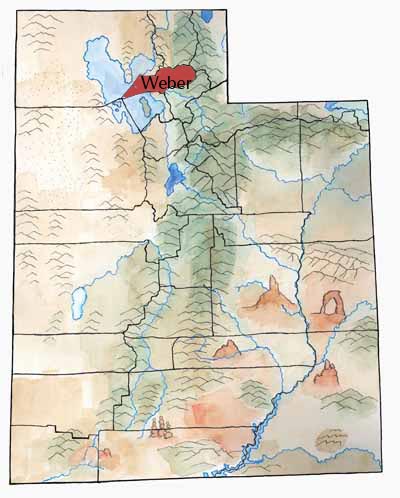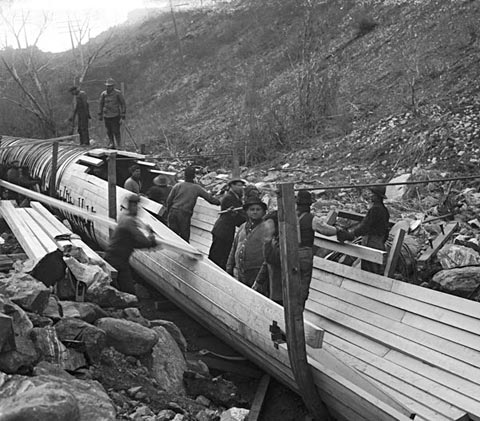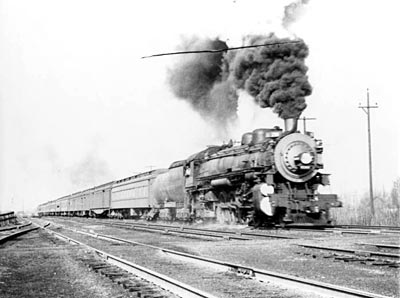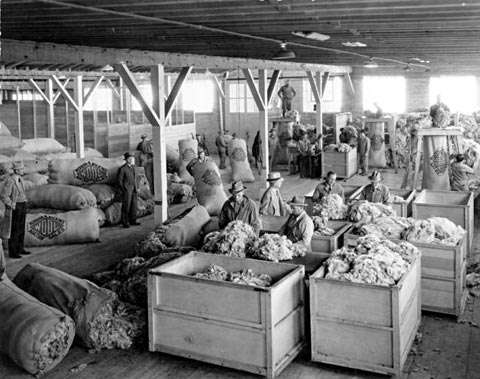Weber County includes a wide swatch of land running from the Wasatch Mountains on the east to the Great Salt Lake on the west. Marshes and shorelines along the lake attract birds.

The mountains rise up to almost 10,000 feet. On the backside of the Wasatch lies the high Ogden Valley.
The Ogden and Weber rivers flow through the county. The Ogden empties into the Weber River after flowing through Ogden Valley, cutting through Ogden Canyon, and passing through the city of Ogden.
The Weber River begins in the high Uintas and also cuts a spectacular canyon as it approaches Ogden. The combined river empties into the Great Salt Lake.
First Peoples
Early people in this area had an advantage over people in drier places: they had access to plants and animals that flourished around marshlands, lakes, and rivers. The people used every kind of animal for food and tools, including crickets, water fowl, fish, and bison. They used roots and bulbs like sego lily and grass seeds.
After the Archaic period, people settled down and didn’t roam so much. These Fremont people used all the foods around them but also grew corn, beans, and squash.
Beginning in about 1300, Shoshone people were the main people in the area, using the land along the Great Salt Lake and Ogden Valley. Sometime after the Spanish arrived, they acquired a few horses and might use them to travel to Wyoming to hunt bison.

These Shoshone also interacted with Utes and other Shoshone groups and lived very well.
But when white people came, new diseases killed many people. The bison disappeared. Settlers and their cattle quickly took over the food resources that once fed the people.
Trappers
The same water that provided so much food for people was also paradise for beaver. And where beaver lived, trappers were sure to come.
Peter Skene Ogden’s party of 58 trappers, 30 women, and 35 children caught lots of beaver in Ogden Valley in 1825. At the same time John Weber and his men were trapping near the present city of Ogden. Etienne Provost and his party were heading down the Weber River.
These groups had an angry confrontation about who had the right to be trapping here. Ogden, who was working for a British company, lost several of his men and lots of money when they took their furs and started working for the Americans.
Settlers

In 1843 horse trader/trapper Miles Goodyear built a fort and trading post on the banks of the Weber River, near where it meets the Ogden River.
Late in 1847 he sold his land to James Brown, a veteran of the Mormon Battalion, for $1,950 in gold coins, and the property became Brown’s Fort, also known as Brownsville. Within three years the community had 1,141 residents.
Later the name changed to Ogden, and the surrounding area became Weber County—the names of the two trappers who fought over their rights to the beaver here.
Railroad and Development

Growth in the county really took off after 1869, when the nation’s first transcontinental railroad was finished on May 10 at Promontory Summit. Fortunately for Ogden’s businesses, the city became the main junction for transferring railroad cars, passengers, and freight. Ogden became known as “Junction City.”
Other industries grew up: woolen mills, canneries, livestock yards, flour mills, breweries, iron works, banks, and hotels, and telephone, telegraph, and power companies.
Ogden inventor John M. Browning not only operated an important business in Ogden but he also became perhaps the world’s greatest genius in gunmaking. In 1879 he patented his new single-shot rifle—the first of more than 100 firearms developed by the Brownings and sold all over the world.
The many African Americans working for the railroad and living in Ogden made the city more multicultural than most of Utah’s cities.
Military

Weber County’s next big population explosion came just before and during World War II, when the military built the Defense Depot Ogden in northern Weber County and Hill Air Force Base and the Naval Supply Depot in nearby Davis County. DDO and Hill continue to provide many jobs for Weber residents.
The war also placed increased demands on the transportation network. On many days during the war, as many as 150 regular and special trains moved through Ogden’s Union Station.
Economy

When people stopped riding railroads, Ogden’s fortunes sank for a time. The Union Station closed, but it was saved to become a museum center. Now the county has become involved in other, space-age kinds of transportation. Several aerospace industries have offices here. Other manufacturing plants build Jetway loading bridges for airports worldwide.
Weber State College, founded in Ogden in 1889, is now a university. Several ski and winter sports companies have moved to Ogden. The U.S. Forest Service regional headquarters, the IRS Service Center, and the McKay-Dee and St. Benedict’s hospitals are among the county’s major employers.
Did You Know?
| In 1846, Miles Goodyear, his wife and children, and friends built a trading post called Fort Buenaventura on the Weber River (near today’s Ogden). Brigham Young later bought the fort from him. |
| Fremont Island, on the Great Salt Lake, is in Weber County. Sheep grazed there. Also, the judge sentenced the grave robber Jean Baptiste to exile on the island. |
| A resort called Utah Hot Springs, at the north of the county, offered horse racing, dancing, a saloon, and dining. |
| David Eccles’s banking empire started with his lumber company, which used lumber cut east of Ogden. |
| Work on the railroad and associated businesses drew many ethnic groups to Ogden. |
Quick Facts
Area: 644 Square Miles
County Seat: Ogden
Where it Got Its Name: Trapper John Weber
Main Cities and Towns: Ogden, Roy, South Ogden, North Ogden, Washington Terrace
Economy: Defense, transportation, warehousing, distribution, retailing, tourism, recreation, healthcare, printing
Keep Exploring!
Return to the County’s home page here.
Return to the I Love Utah History home page here.